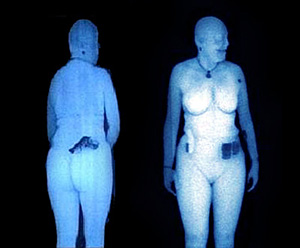
|
 |
 |
 Travel & Outdoors | June 2008 Travel & Outdoors | June 2008  
New Airport Security Scans Will Show Sex Organs
 Agence France-Presse Agence France-Presse
go to original


| | New airport scanners can see underneath clothes | | |
Security scanners that can see through passengers' clothing and reveal details such as their sex organs, colostomy bags and breast size, are being installed in 10 US airports.

A random selection of travellers getting ready to board airplanes in Washington, New York's Kennedy, Los Angeles and other key hubs will be shut in the glass booths while a three-dimensional image is made of their body beneath their clothes.

The booths close around the passenger and emit "millimetre waves" that go through cloth to identify metal, plastics, ceramics, chemical materials and explosives, according to the Transport Safety Authority.

While it allows the security screeners - looking at the images in a separate room - to clearly see the passenger's sexual organs as well as other details of their bodies, the passenger's face is blurred, TSA said.

The scan only takes seconds and is to replace the physical pat-downs of people that is currently widespread in airports.

TSA began introducing the body scanners in airports in April, first in the Phoenix, Arizona terminal.

The installation is picking up this month, with machines in place or planned for airports in Washington (Reagan National and Baltimore-Washington International), Dallas, Las Vegas, Albuquerque, Miami and Detroit.

The new machines have provoked worries among passengers and rights activists.

"People have no idea how graphic the images are," Barry Steinhardt, director of the technology and liberty program at the American Civil Liberties Union, said.

The ACLU said passengers expecting privacy underneath their clothing "should not be required to display highly personal details of their bodies such as evidence of mastectomies, colostomy appliances, penile implants, catheter tubes and the size of their breasts or genitals as a pre-requisite to boarding a plane".

Besides masking their faces, the TSA says on its website, the images made "will not be printed stored or transmitted".

"Once the transportation security officer has viewed the image and resolved anomalies, the image is erased from the screen permanently. The officer is unable to print, export, store or transmit the image."

Lara Uselding, a TSA spokeswoman, said passengers were not obliged to accept the new machines.

"The passengers can choose between the body imaging and the pat-down," she said.

TSA foresees 30 of the machines installed across the country by the end of 2008. In Europe, Amsterdam's Schipol airport is already using the scanners. | 
 | |
 |



